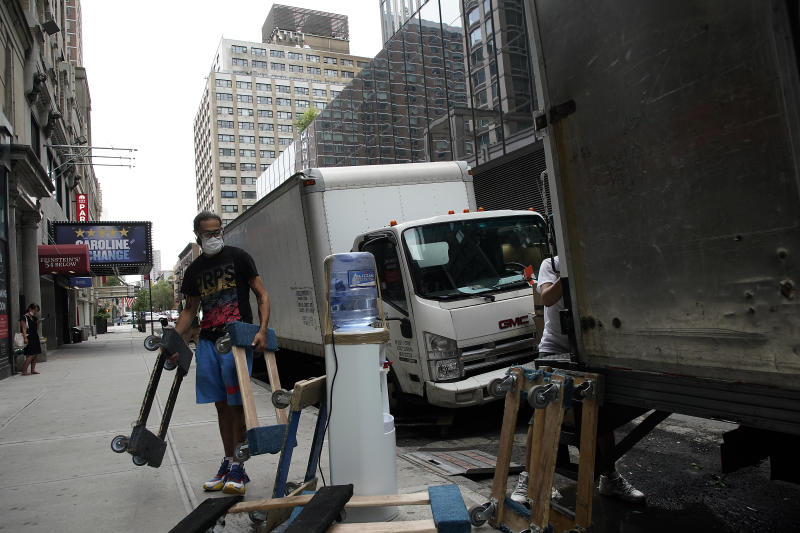
The US economy added back a greater than expected number of payrolls in August.
Here were the main metrics from the report, compared to consensus estimates compiled by Bloomberg:
Change in non-farm payrolls: 1.371 million vs. +1.350 million expected, vs. +1.763 million in July
Unemployment rate: 8.4% vs. 9.8% expected, vs. 10.2% in July
Average hourly earnings, month over month: 0.4% vs. 0.0% expected, +0.2% in July
Average hourly earnings, year over year: 4.7% vs. 4.4% expected, 4.8% in July
Labor force participation rate: 61.7% vs. 61.8% expected, 61.4% in July
Even with another print above 1 million, the number of non-farm payrolls added in August has not come close to fully plugging the deficit created during the earlier months of the pandemic. In March and April, nonfarm payrolls plunged 1.373 million and then by a record 20.787 million, respectively, is a testament to the devastating blow the virus dealt with the US economy. Payrolls in June had risen by a record 4.791 million, after a gain of 2.725 million in May.
The unemployment rate was expected to improve modestly to 9.8% in August, for the first reading below 10% since March. That said, an expected bump up in the labor force participation rate was expected to stifle further improvements in the unemployment rate since more individuals would have been counted as out of work but looking for employment. At the 61.8%, the expected August labor force participation rate would have improved by 1.6 percentage points from the pandemic-era low, but held at a level that would have been the worst since the 1970s before the pandemic struck.
Economists and officials have also now focused more closely on the Labor Department’s data on “permanent job losers,” or those who do not expect to be called back from temporary layoffs. In July’s payrolls report, the number of permanent job losers was a virtually unchanged month over month at 2.9 million, holding stubbornly at that level even as other metrics in the jobs report improved.

“The duration of unemployment acts as an additional headwind to a robust jobs recovery, even as the number of unemployed workers decreases,” said John Leer, an economist at data intelligence company Morning Consult. “History has shown that it becomes increasingly difficult for unemployed workers to find jobs the longer they remain unemployed, either because they lose the skills they need to compete, or due to the stigma of long-term unemployment.”
Concerns that a sizable portion of the working-age population could be out of work for the long-term in the wake of the pandemic have not been lost on policymakers. Federal Reserve officials on Wednesday highlighted in their September Beige Book, “Employment increased overall among Districts, with gains in manufacturing cited most often,” in the period up until August 24. However, they added that “some Districts also reported slowing job growth and increased hiring volatility, particularly in service industries, with rising instances of furloughed workers being laid off permanently as demand remained soft.”
Ahead of the August jobs report, other data on the state of the US labor market in late summer came in mixed. ADP’s report out Wednesday on private payrolls showed 428,000 jobs were added in August, sharply missing estimates for 1 million. The report, however, has consistently undershot the results of the Department of Labor’s jobs release, especially during the pandemic.
Elsewhere, the Institute for Supply Management’s (ISM) manufacturing and service sector employment indices showed further improvements in August from earlier this summer, but each still held in contractionary territory. And leading up to the jobs report survey week in mid-August, the Labor Department’s report on weekly jobless claims showed an improvement in the number of new unemployment claims filed relative to July.
August jobs report in a nutshell via @katiadmi
— Bloomberg (@business) September 4, 2020
- Improvements are slowing from prior months as businesses and states run out of cash, though they’re still hiring https://t.co/teC4QABIte pic.twitter.com/YclCbzVMe3
Breaking News: The U.S. added 1.4 million jobs in August as employers brought back workers, but at a slower pace than in spring. The unemployment rate fell to 8.4%. https://t.co/0HYGWXE0SR
— The New York Times (@nytimes) September 4, 2020
JUST IN: U.S. employers added 1.37 million payrolls in August (1.35 million expected), unemployment rate fell to 8.4% (9.8% expected) https://t.co/s8unNkfrm4 pic.twitter.com/nUIibFOVNj
— Yahoo Finance (@YahooFinance) September 4, 2020
Unemployment declined more than expected, new positions came in inline with forecasts.
— Bloomberg Markets (@markets) September 4, 2020
Wages increased 4.7% yoy https://t.co/PsutqUoybm pic.twitter.com/eSgDnAPgoy
